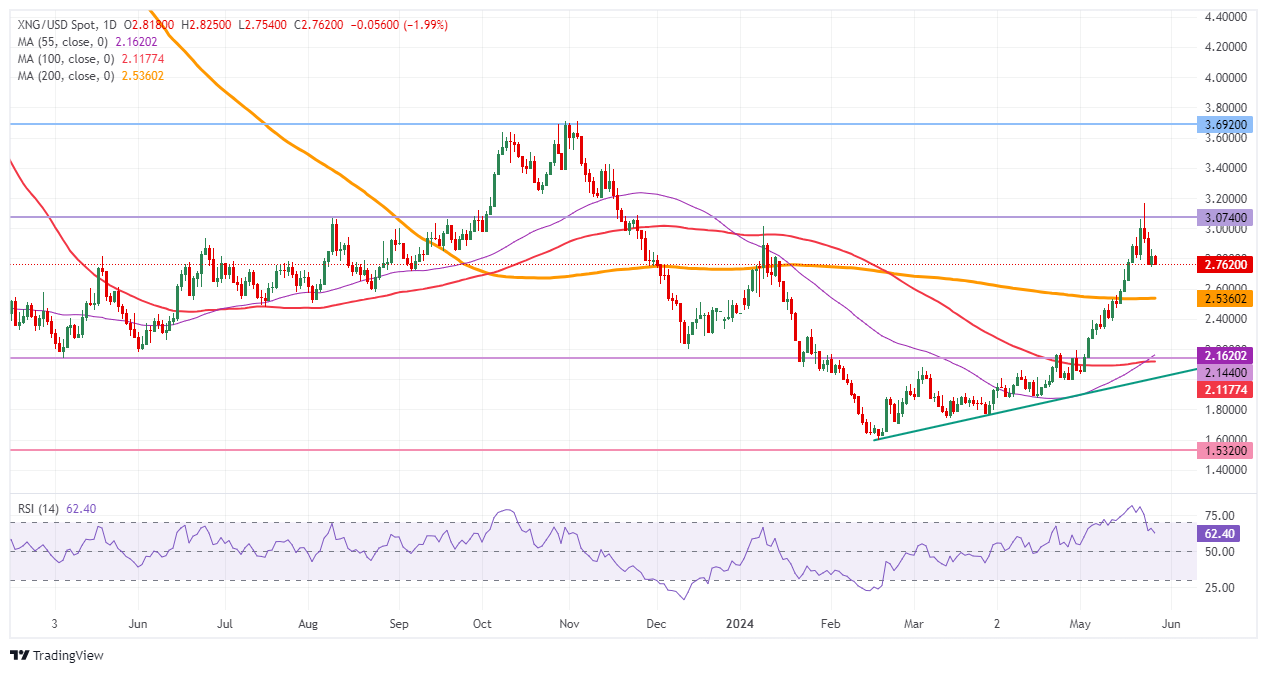Natural Gas prints fresh weekly low with political turmoil in Israel possibly resulting in swift ceasefire for Gaza

- Natural Gas prices slide over 2% amid reports that Israeli opposition parties discuss plans to oust Prime Minister Benjamin Netanyahu.
- Ireland, Norway and Spain have officially recognized the Palestinian state as strikes over Rafah continue.
- The US Dollar Index retreats further, testing the last lines of defense.
Natural Gas price (XNG/USD) is testing this week’s low on Tuesday after prices fell on Monday due to extensive profit-taking. The decline on Tuesday comes on the back of headlines that the opposition in Israel is planning to meet on Wednesday to look for ways to oust Prime Minister Benjamin Netanyahu. Tensions build up in Israel after several world nations expressed their concerns after the attack on a refugee camp in Rafah, which killed at least 45 people.
Meanwhile, the US Dollar Index (DXY) eases further on Tuesday ahead of the official start of the week for US markets after a bank holiday on Monday for Memorial Day. The retreat comes after warnings from Japanese Finance Minister Shun’ichi Suzuki, who pushed against any attempts to further devalue the Japanese Yen by saying that every measure is at their disposal in order to assure a stable exchange rate. The US economic agenda is set to kick off with a slew of data and four US Federal Reserve (Fed) speakers.
Natural Gas is trading at $2.75 per MMBtu at the time of writing.
Natural Gas news and market movers: US caught between a rock and a hard place on Israel
- On Tuesday morning witnesses reported to Reuters that tanks have reached the outskirts of Rafah City.
- Israeli opposition leader Yair Lapid, Yisrael Beytenu chairman Avigdor Liberman, and New Hope chairman Gideon Sa’ar are set to meet on Wednesday to discuss the creation of an alternative government and removing Israeli Prime Minister Benjamin Netanyahu from his function, KAN reports citing sources.
- Newswire Axios reported that the US is still assessing whether Israel violated a red line with the Rafah strikes.
- Bloomberg’s Power and Gas research calculated that, despite the current hiccups in supply, the European bloc is still set to hit a 100% full Gas storage inventory ahead of the winter season.
Natural Gas Technical Analysis: Ceasefire would mean nosediving correction
Natural Gas is sliding lower with rumors of possibly an opposition coalition formation that could take over power from current ruling Prime Minister Benjamin Nethanyahu, an event that could de-escalate the situation in the region. After the Rafah massacre over the weekend, international disapproval is growing and even the US is seeing how its arguments to stand by Israel are starting to run out. If a new coalition took control of the government, the current offensive in Gaza could be ended and recalled, easing tensions in the region.
The $3.00 marker as a big figure was easily broken on Wednesday. The pivotal level near $3.07 (high of March 6, 2023) remains key as prices failed to post a daily close above it. Further up, the fresh year-to-date high at $3.16 is the level to beat.
On the downside, the 200-day Simple Moving Average (SMA) is acting as first support near $2.53. Should that support area fail to hold, then the pivotal level near $2.14 should do the trick ahead of $2.11, where both the 55-day and 100-day SMA are trading.
Natural Gas: Daily Chart
Natural Gas FAQs
Supply and demand dynamics are a key factor influencing Natural Gas prices, and are themselves influenced by global economic growth, industrial activity, population growth, production levels, and inventories. The weather impacts Natural Gas prices because more Gas is used during cold winters and hot summers for heating and cooling. Competition from other energy sources impacts prices as consumers may switch to cheaper sources. Geopolitical events are factors as exemplified by the war in Ukraine. Government policies relating to extraction, transportation, and environmental issues also impact prices.
The main economic release influencing Natural Gas prices is the weekly inventory bulletin from the Energy Information Administration (EIA), a US government agency that produces US gas market data. The EIA Gas bulletin usually comes out on Thursday at 14:30 GMT, a day after the EIA publishes its weekly Oil bulletin. Economic data from large consumers of Natural Gas can impact supply and demand, the largest of which include China, Germany and Japan. Natural Gas is primarily priced and traded in US Dollars, thus economic releases impacting the US Dollar are also factors.
The US Dollar is the world’s reserve currency and most commodities, including Natural Gas are priced and traded on international markets in US Dollars. As such, the value of the US Dollar is a factor in the price of Natural Gas, because if the Dollar strengthens it means less Dollars are required to buy the same volume of Gas (the price falls), and vice versa if USD strengthens.
